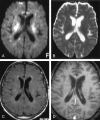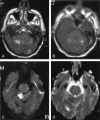West Nile virus infection: MR imaging findings in the nervous system
- PMID: 15709126
- PMCID: PMC7974109
West Nile virus infection: MR imaging findings in the nervous system
Abstract
Background and purpose: West Nile virus (WNV) infection is an ongoing seasonal epidemic. We correlated the MR imaging findings with the clinical presentations and outcomes of WNV infection.
Methods: We reviewed 14 brain and three spinal MR images: nonenhanced and contrast-enhanced T1-weighted images (T1WIs) and T2-weighted images (T2WIs), nonenhanced fluid-attenuated inversion recovery (FLAIR) images (11 patients) and enhanced FLAIR images (three patients), with diffusion-weighted (DW) images and apparent diffusion coefficient maps. WNV infection was diagnosed by means of enzyme-linked immunosorbent assay with a plaque reduction neutralization test. We also correlated the MR findings with the clinical presentation, course, and outcome to determine their prognostic importance.
Results: MR imaging findings included: 1) normal (five patients); 2) DW imaging-only abnormalities in the white matter, corona radiata, and internal capsule (four patients); 3) hyperintensity on FLAIR images and T2WIs in the lobar gray and white matter, cerebellum, basal ganglia, thalamus and internal capsule, pons and midbrain (three patients); 4) meningeal involvement (two patients); and 5) spinal cord, cauda equina, and nerve root involvement (three patients). All patients with finding 1 and all but one with finding 2 recovered completely. Two patients with finding 3 died. Those with finding 4 or 5 had residual neurologic deficits that were severe or moderate to severe, respectively.
Conclusion: Patients with normal MR images or abnormalities on only DW images had the best prognosis, while those with abnormal signal intensity on T2WI and FLAIR images had the worst outcomes. No definite predilection for any specific area of the brain parenchyma was noted.
Figures









References
-
- Centers for Disease Control Prevention. West Nile Virus: Statistics, Surveillance and Control. 2003 West Nile Virus Activity in the United States. Available at: www.cdc.gov/ncidod/dvbid/westnile/surv&controlCaseCount03_detailed.htm Accessed May 24,2004
-
- Centers for Disease Control and Prevention. Provisional surveillance summary of the West Nile Virus epidemic: United States, January–November 2002. MMWR Morb Mortal Wkly Rep 2002;51:1129–1133 - PubMed
-
- Centers for Disease Control and Prevention. West Nile activity: United States, 2001. MMWR Morb Mortal Wkly Rep 2002;51:497–501 - PubMed
-
- Centers for Disease Control and Prevention. National West Nile Virus Surveillance System, 2000: Final Plan, May 2000, Atlanta, GA . Available at: www.cdc.gov/ncidod/dvbid/westnile/resources/wn_final_plan_2000_05_26_31.pdf. Accessed May2004
MeSH terms
LinkOut - more resources
Full Text Sources
Medical
